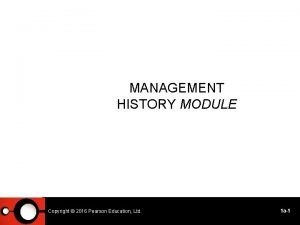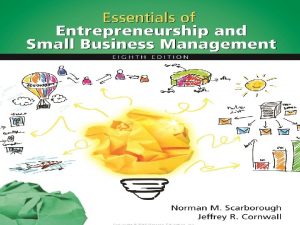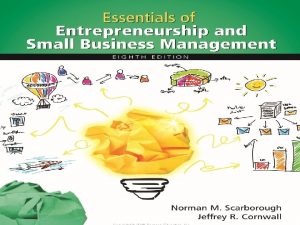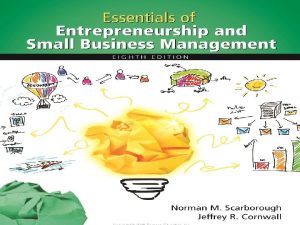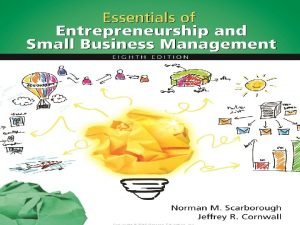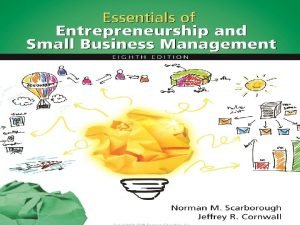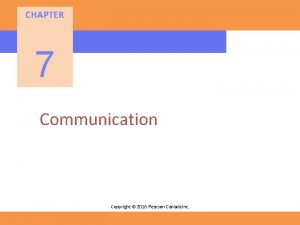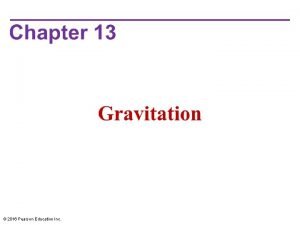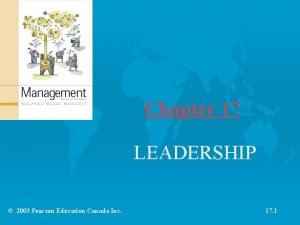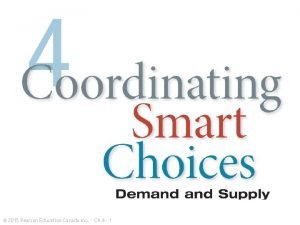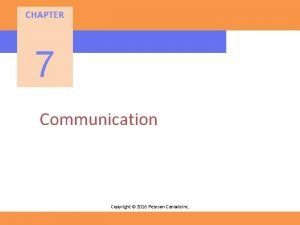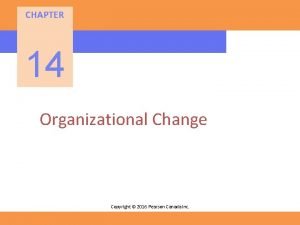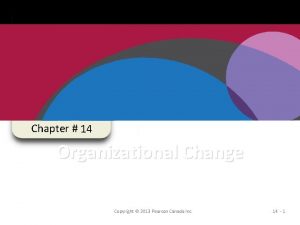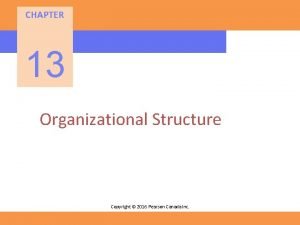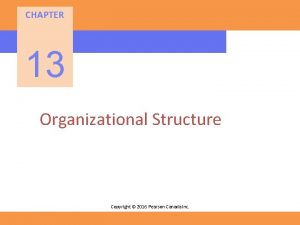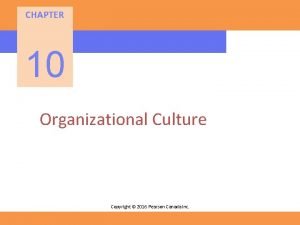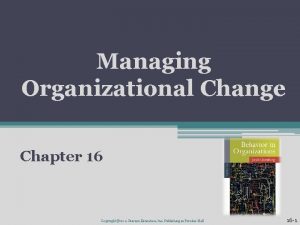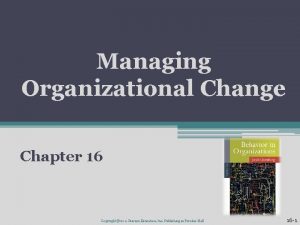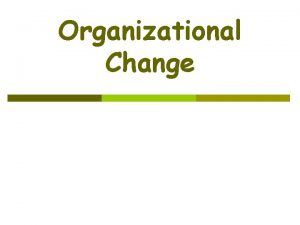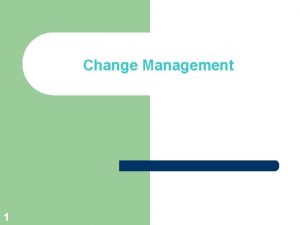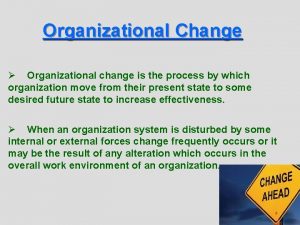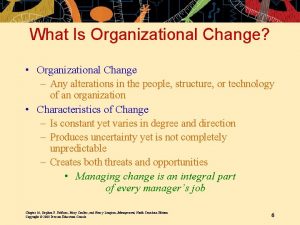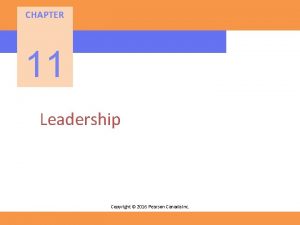CHAPTER 14 Organizational Change Copyright 2016 Pearson Canada
















































- Slides: 48

CHAPTER 14 Organizational Change Copyright © 2016 Pearson Canada Inc.

Chapter Outline • Forces for Change – Opportunities for Change – Change Agents • Approaches to Managing Change – – Lewin’s Three-Step Model Kotter’s Eight-Step Plan for Implementing Change Action Research Appreciative Inquiry Copyright © 2016 Pearson Canada Inc.

Chapter Outline • Resistance to Change – – Individual Resistance Organizational resistance Overcoming Resistance to Change The Politics of Change • Creating a Culture for Change – Stimulating a Culture of Innovation – Creating a Learning Organization Copyright © 2016 Pearson Canada Inc.

Learning Outcomes 1. Identify the forces for change. 2. Compare the four main approaches to managing organizational change 3. Describe the sources of resistance to change. 4. Describe two ways to create a culture for change. Copyright © 2016 Pearson Canada Inc.

Forces for Change • • • Nature of the workforce Technology Economic shocks Competition Social Trends World politics Copyright © 2016 Pearson Canada Inc.

Exhibit 14 -1 Forces for Change Copyright © 2016 Pearson Canada Inc.

Organizational Targets for Change • Purpose • People • Technology • Culture • Structure • Strategy • Tasks • Objective Copyright © 2016 Pearson Canada Inc.

Exhibit 14 -2 Organizational Targets for Change Copyright © 2016 Pearson Canada Inc.

Change Agents • People who act as catalysts and assume the responsibility for managing change activities. – Managers or non managers – Employees of the organization – Outside consultants Copyright © 2016 Pearson Canada Inc.

Change Agents Outside agents • Can offer an objective perspective. • Usually have an inadequate understanding of the organization’s history, culture, operating procedures, and personnel. • Don’t have to live with the repercussions after the change is implemented. Internal agents • Have to live with the consequences of their actions. • May be more thoughtful. • May be more cautious. Copyright © 2016 Pearson Canada Inc.

Approaches To Managing Change • Lewin’s Three-Step Model • Kotter’s Eight-Step Plan for Implementing Change • Action Research • Appreciative Inquiry Copyright © 2016 Pearson Canada Inc.

Lewin’s Three-Step Model • Unfreezing – Change efforts to overcome the pressures of both individual resistance and group conformity. • Moving – Efforts to get employees involved in the change process. • Refreezing – Stabilizing a change intervention by balancing driving and restraining forces. Copyright © 2016 Pearson Canada Inc.

Exhibit 14 -3 Lewin’s Three-Step Change Model Copyright © 2016 Pearson Canada Inc.

Exhibit 14 -4 Unfreezing the Status Quo Copyright © 2016 Pearson Canada Inc.

Driving Forces, Restraining Forces or Both • Unfreezing must happen in one of three ways: 1. Driving forces, which direct behaviour away from the status quo, can be increased. 2. Restraining forces, which hinder movement from the existing equilibrium, can be decreased. 3. Combine both two approaches. Copyright © 2016 Pearson Canada Inc.

Unfreezing • Arouse dissatisfaction with the current state. • Activate and strengthen top management support. • Use participation in decision making. • Build in rewards. Copyright © 2016 Pearson Canada Inc.

Moving • Establish goals. • Institute smaller, acceptable changes that reinforce and support change. • Develop management structures for change. • Maintain open, two-way communication. Copyright © 2016 Pearson Canada Inc.

Refreezing • Build success experiences • Reward desired behaviour • Develop structures to institutionalize the change • Make change work Copyright © 2016 Pearson Canada Inc.

Kotter: Eight Common Failures in Initiating Change • • • The inability to create a sense of urgency. Failure to create a coalition. The absence of a vision for change. Not removing obstacles. Failure to provide short-term and achievable goals. • The tendency to declare victory too soon. • Not anchoring the changes in the organization’s culture. Copyright © 2016 Pearson Canada Inc.

Exhibit 14 -5 Kotter’s Eight-Step Plan for Implementing Change Copyright © 2016 Pearson Canada Inc.

Action Research • A change process based on the systematic collection of data and then selection of a change action based on what the analyzed data indicate. • The Process of Action Research – Diagnosis – Analysis – Feedback – Action – Evaluation Copyright © 2016 Pearson Canada Inc.

Appreciative Inquiry • An approach to change that seeks to identify the unique qualities and special strengths of an organization, which can then be built on to improve performance. • Steps of Appreciative Inquiry: the “Four D’s” – Discovery – Dreaming – Design – Destiny Copyright © 2016 Pearson Canada Inc.

Exhibit 14 -6 The “Four D’s” of Appreciative Inquiry Copyright © 2016 Pearson Canada Inc.

Resistance to Change • Resistance to change can be positive if it leads to open discussion and debate. • Resistance to change does not necessarily surface in standardized ways. • It can be: – Overt – Implicit – Immediate – Deferred Copyright © 2016 Pearson Canada Inc.

Exhibit 14 -7 Sources of Individual Resistance to Change Copyright © 2016 Pearson Canada Inc.

Cynicism About Change • Feeling uninformed about what was happening. • Lack of communication and respect from one’s supervisor. • Lack of communication and respect from one’s union representative. • Lack of opportunity for meaningful participation in decision-making. Copyright © 2016 Pearson Canada Inc.

Six Major Sources of Organizational Resistance • • • Structural inertia Limited focus of change Group inertia Threat to expertise Threat to established power relationships Threat to established resource allocations Copyright © 2016 Pearson Canada Inc.

Exhibit 14 -8 Sources of Organizational Resistance to Change Copyright © 2016 Pearson Canada Inc.

Overcoming Resistance to Change • Education and communication – This tactic assumes that the source of resistance lies in misinformation or poor communication. – Best used: Lack of information, or inaccurate information • Participation and involvement – Prior to making a change, those opposed can be brought into the decision process. – Best used: Where initiators lack information, and others have power to resist • Building support and commitment – Employee counselling and therapy, new-skills training, or a short paid leave of absence may facilitate adjustment. – Best used: To help employees emotionally commit to the change Copyright © 2016 Pearson Canada Inc.

Overcoming Resistance to Change • Developing positive relationships – Establish trust in the managers implementing the change. – Best used: When one has a more positive relationship with supervisors and who felt that the work environment supported development • Implementing changes fairly – Make sure the change is implemented fairly. – Best used: When employees perceive an outcome as negative, so its crucial that employees see the reason for the change and perceive its implementation as fair. Copyright © 2016 Pearson Canada Inc.

Overcoming Resistance to Change • Manipulation and co-optation – Twisting and distorting facts to make them appear more attractive. – Best used: Where other tactics won’t work or are too expensive • Selecting people who accept the change – Open to the experience and take a positive attitude toward change. – Best used: when selecting people predisposed to accept change to facilitate the change. • Explicit and implicit coercion – The application of direct threats or force upon resisters. – Best used: Speed is essential, and initiators have power Copyright © 2016 Pearson Canada Inc.

Politics of Change • The demand for change is more likely to come from: – outside change agents – employees who are new to the organization – managers who are slightly removed from the main power structure • Employees who have spent their entire career with the organization are often major impediments to change. Copyright © 2016 Pearson Canada Inc.

Creating a Culture for Change • Organizations embrace change by transforming their cultures through two approaches: – Stimulating a Culture of Innovation – Creating a Learning Organization Copyright © 2016 Pearson Canada Inc.

Stimulating a Culture of Innovation • Innovation – A new idea applied to initiating or improving a product, process, or service. • Sources of Innovation – Structural variables – Cultures – Human resources Copyright © 2016 Pearson Canada Inc.

Stimulating a Culture of Innovation • Structural Variables – – Organic structures positively influence innovation Long tenure in management is associated with innovation Innovation is nurtured when there are slack resources Interunit communication is high in innovative organizations • Cultures – Encourage experimentation – Reward both successes and failures – Celebrate mistakes Copyright © 2016 Pearson Canada Inc.

Stimulating a Culture of Innovation • Human resources: – Actively promote the training and development of their members – Offer high job security – Encourage individuals to become idea champions – Champions have common personality characteristics: high self-confidence, persistence, energy, and a tendency to take risks Copyright © 2016 Pearson Canada Inc.

Creating a Learning Organization • Learning Organization: An organization that has developed the continuous capacity to adapt and change. – Single-loop learning • Errors are corrected using past routines and present policies. – Double-loop learning • Errors are corrected by modifying the organization’s objectives, policies, and standard routines. Copyright © 2016 Pearson Canada Inc.

Creating a Learning Organization • Three fundamental problems of traditional organizations: 1. Fragmentation • Based on specialization creates “walls” and “chimneys” that separate different functions into independent and often warring fiefdoms 2. Competition • An overemphasis on competition often undermines collaboration. 3. Reactiveness • Misdirects management’s attention to problem solving rather than creation. Copyright © 2016 Pearson Canada Inc.

Managing Learning • Establish a strategy. • Redesign the organization’s structure. • Reshape the organization’s culture. Copyright © 2016 Pearson Canada Inc.

Exhibit 14 -9 Characteristics of a Learning Organization Copyright © 2016 Pearson Canada Inc.

Global Implications • Do people believe change is possible? – Cultures vary in terms of beliefs about their ability to control their environment • If change is possible, how long will it take to bring it about? – Depends on a culture’s time orientation • Is resistance to change greater in some cultures than in others? – Resistance to change will be influenced by a society’s reliance on tradition Copyright © 2016 Pearson Canada Inc.

Global Implications • Does culture influence how change efforts will be implemented? – In high power distance cultures change efforts will tend to be autocratically implemented by top management • Do successful idea champions do things differently in different cultures? – Effective managers will alter their organization’s championing strategies to reflect cultural values Copyright © 2016 Pearson Canada Inc.

Summary 1. Individuals resist change; breaking down that resistance is important. 2. Change requires unfreezing the status quo, moving to a new state, and making the new change permanent. 3. Innovative cultures reward both successes and failures so that people are not afraid to make mistakes. Copyright © 2016 Pearson Canada Inc.

OB at Work: For Review 1. What are the forces for change? 2. What are the four main approaches to managing organizational change? 3. What forces act as sources of resistance to change? 4. How can managers create a culture for change? Copyright © 2016 Pearson Canada Inc.

OB at Work: For Managers ■ Consider that, as a manager, you are a change agent in your organization. The decisions you make and your role-modelling behaviour will help shape the organization’s change culture. ■ Your management policies and practices will determine the degree to which the organization learns and adapts to changing environmental factors. Copyright © 2016 Pearson Canada Inc.

OB at Work: For Managers ■ People resist change because change can be stressful. Low to moderate amounts of stress enable many people to perform their jobs better by increasing their work intensity, alertness, and ability to react. Therefore, don’t hesitate to introduce change just because stress might be induced. Copyright © 2016 Pearson Canada Inc.

Breakout Group Exercises • Form small groups to discuss the following: 1. Identify a local company that you think needs to undergo change. What factors suggest that change is necessary? 2. Have you ever tried to change the behaviour of someone you worked with (for instance, someone in one of your project groups)? How effective were you in getting change to occur? How would you explain this? 3. Identify a recent change that your college or university introduced, and its effects on the students. Did the students accept the change or fight it? How would you explain this? Copyright © 2016 Pearson Canada Inc.

Concepts to Skills: Carrying Out Organizational Change • • Build an intricate understanding of the business. Encourage uncompromising straight talk. Manage from the future. Harness setbacks. Promote inventive accountability. Understand the quid pro quo. Create relentless discomfort with the status quo. Copyright © 2016 Pearson Canada Inc.
 Pearson education inc 4
Pearson education inc 4 2016 pearson education inc
2016 pearson education inc 2016 pearson education inc
2016 pearson education inc Pearson education inc 1
Pearson education inc 1 2016 pearson education inc
2016 pearson education inc 2016 pearson education inc
2016 pearson education inc 2016 pearson education inc
2016 pearson education inc 2016 pearson education inc
2016 pearson education inc 2016 pearson education inc
2016 pearson education inc 2016 pearson education inc
2016 pearson education inc 2016 pearson education inc
2016 pearson education inc 2016 pearson education inc
2016 pearson education inc 2016 pearson education inc
2016 pearson education inc 2016 pearson education inc
2016 pearson education inc Copyright pearson education inc
Copyright pearson education inc 2017 pearson education inc
2017 pearson education inc Copyright 2010 pearson education inc
Copyright 2010 pearson education inc Copyright 2009 pearson education inc
Copyright 2009 pearson education inc Copyright pearson education inc
Copyright pearson education inc 2014 pearson education inc
2014 pearson education inc Copyright 2010 pearson education inc
Copyright 2010 pearson education inc Copyright 2010 pearson education inc
Copyright 2010 pearson education inc Copyright by pearson education inc. answers
Copyright by pearson education inc. answers 2008 pearson education inc
2008 pearson education inc Copyright 2005 pearson prentice hall inc
Copyright 2005 pearson prentice hall inc Copyright 2009 pearson education inc
Copyright 2009 pearson education inc Copyright pearson education inc
Copyright pearson education inc Copyright 2010 pearson education inc
Copyright 2010 pearson education inc Copyright 2010 pearson education inc
Copyright 2010 pearson education inc Copyright 2010 pearson education inc
Copyright 2010 pearson education inc 2010 pearson education inc
2010 pearson education inc Copyright 2010 pearson education inc
Copyright 2010 pearson education inc Copyright 2010 pearson education inc
Copyright 2010 pearson education inc Copyright 2010 pearson education inc
Copyright 2010 pearson education inc Copyright 2009 pearson education inc
Copyright 2009 pearson education inc 2009 pearson education inc
2009 pearson education inc Copyright 2009 pearson education inc
Copyright 2009 pearson education inc 2009 pearson education inc
2009 pearson education inc Copyright pearson education inc
Copyright pearson education inc Chapter 18 organizational change and stress management
Chapter 18 organizational change and stress management Pearson education canada
Pearson education canada Pearson publishing canada
Pearson publishing canada Pearson canada inc.
Pearson canada inc. Pearson education, inc. publishing as prentice hall
Pearson education, inc. publishing as prentice hall 2011 pearson education inc
2011 pearson education inc Robert whelan
Robert whelan Stress management for life 5th edition
Stress management for life 5th edition Pearson education inc publishing as pearson prentice hall
Pearson education inc publishing as pearson prentice hall Pearson 2012
Pearson 2012


